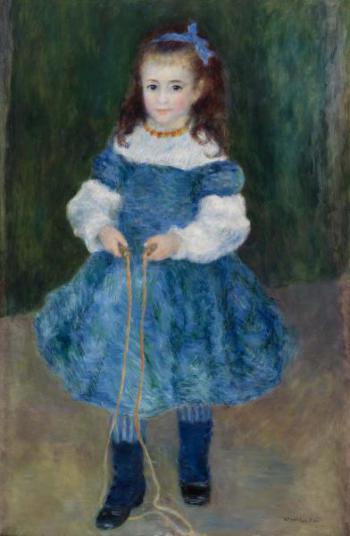Serendip is an independent site partnering with faculty at multiple colleges and universities around the world. Happy exploring!
Delphine Legrand and I

 I saw Girl with a Jump Rope by Pierre-Auguste Renoir appear from behind a middle-aged art father in a dark brown coat. She was placed above an antique table with two antique vases on the middle of the wall in the gallery. I approached her and was struck the most by a sense of unexplainable familiarity. I swear I had seen her before somewhere. Her eyes were the first to come alive. They were her the only features of the painting that were not crafted from fluttery impressionist brush strokes. They were bright, keen, old and youthful at the same time. Her face followed. Her face, absent of the normal amount of baby fat for an eight/nine year old, is unusually chiseled even though her small mouth and cheekbones are in soft focus. Her dress color is what turned her from a porcelain face to a live creature. It is my favorite color of blue. A lively cornflower blue with strokes of rich green. It brings out the dark red in her dark waves tied with a ribbon. Her navy leg-warmers and striped tights complete the look.
I saw Girl with a Jump Rope by Pierre-Auguste Renoir appear from behind a middle-aged art father in a dark brown coat. She was placed above an antique table with two antique vases on the middle of the wall in the gallery. I approached her and was struck the most by a sense of unexplainable familiarity. I swear I had seen her before somewhere. Her eyes were the first to come alive. They were her the only features of the painting that were not crafted from fluttery impressionist brush strokes. They were bright, keen, old and youthful at the same time. Her face followed. Her face, absent of the normal amount of baby fat for an eight/nine year old, is unusually chiseled even though her small mouth and cheekbones are in soft focus. Her dress color is what turned her from a porcelain face to a live creature. It is my favorite color of blue. A lively cornflower blue with strokes of rich green. It brings out the dark red in her dark waves tied with a ribbon. Her navy leg-warmers and striped tights complete the look.
She looked at me, and I looked back at her. She smiled, I smiled. I noticed her orange necklace then. We had a moment. At least, I had a moment of deep play.
I sat down next to an elderly couple. They looked sideways at me. I was the only one on the first floor under the age of twenty.
I sank back into my deep play state. I let my conscious out for a romp this time. I noticed how the green around the girl was a tad darker than the rest of the bush behind her. I think Renoir intentionally painted the whole bush darker so it didn’t look like she has a green halo. I saw her baby hairs whispering out of her hairline and how she is stepping on the jump rope to get any potential kinks out of it. I looked closer at her face again and my subconscious flashed a thought I used to have as an eight year old. I used to picture a girl in my minds-eye that bore remarkable resemblance to the one I was looking at. Same rosy cheeks, red/brown/black curls, inconspicuous ears. She didn’t represent how I wanted to look in the mirror. She was the protagonist of my own story. Whenever I would recreate old memories, whether in dreams or daydreams, she was the one that played me.
Now, here she is. Her name was Delphine Legrand. She lived in the nineteenth century, probably near Paris as that was where Renoir was living at the time. I did some research into the the Legrand connection with Renoir. I had spun my own history of Delphine; I wanted to find her real history next. Intriguingly, one of Renoir’s models was called Marguerite Legrand. She modeled for him 1875 to 1879. The painting was created in 1876. I can assume that Renoir met Delphine through Marguerite. He always loved to paint women and children. Renoir did paint another portrait of Delphine in 1875 (it hangs in the Philadelphia Museum of Art). In this one, her hair is a brown/gold hue and she looks significantly older, even though this portrait precedes the one I saw at Barnes. In this one, she wears a sombre black dress over the same puffy sleeves. Her ribbon is now daintily tied around her neck.
I found Marguerite in Bal du Moulin de la Galette, one of Renoir’s iconic pieces. The two don’t have the same features, and Delphine’s blue theme doesn’t appear in her. At this point, I resigned to go find Delphine’s portrait at the Philadelphia Museum of Art and ask a tour guide to tell me more about her. The internet isn’t putting out this time. Until then, I will lightly ponder why I want to find out more about her in the first place. Isn’t art supposed to be about personal interpretation? Depends who you ask. If you’re asking me, I think I need to truly explore more of the art world to answer that. I am so grateful this class is pushing me to do that.


